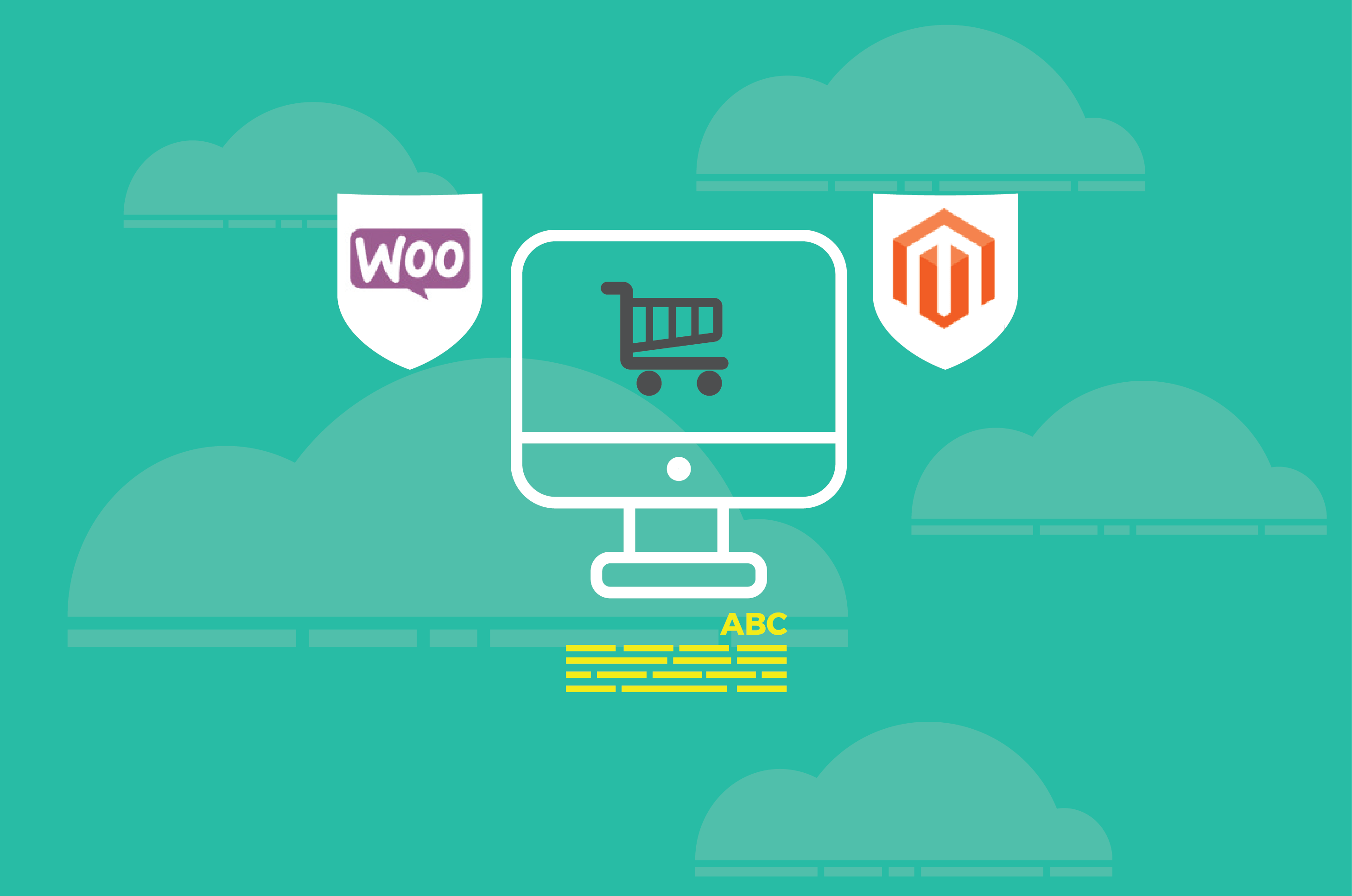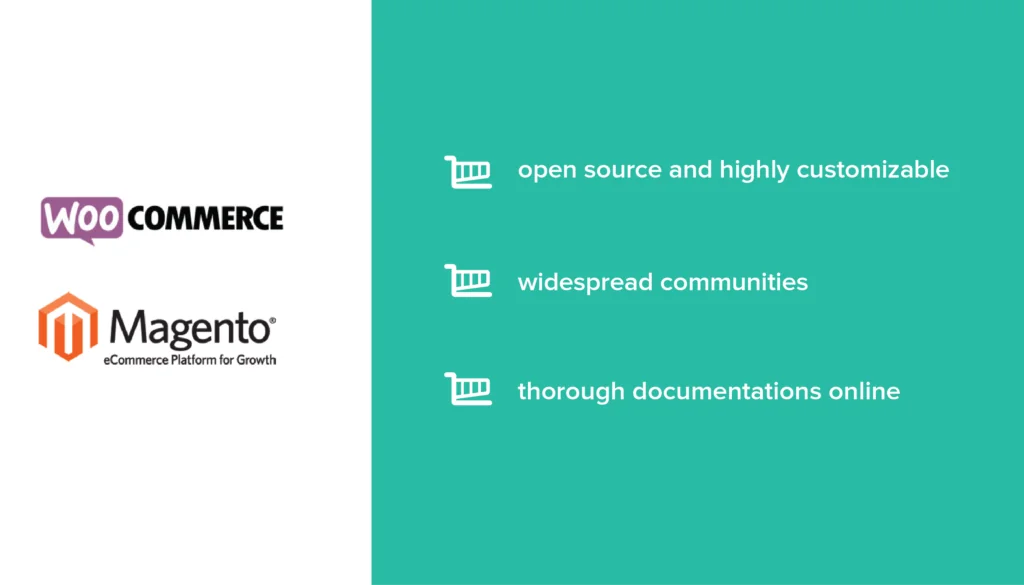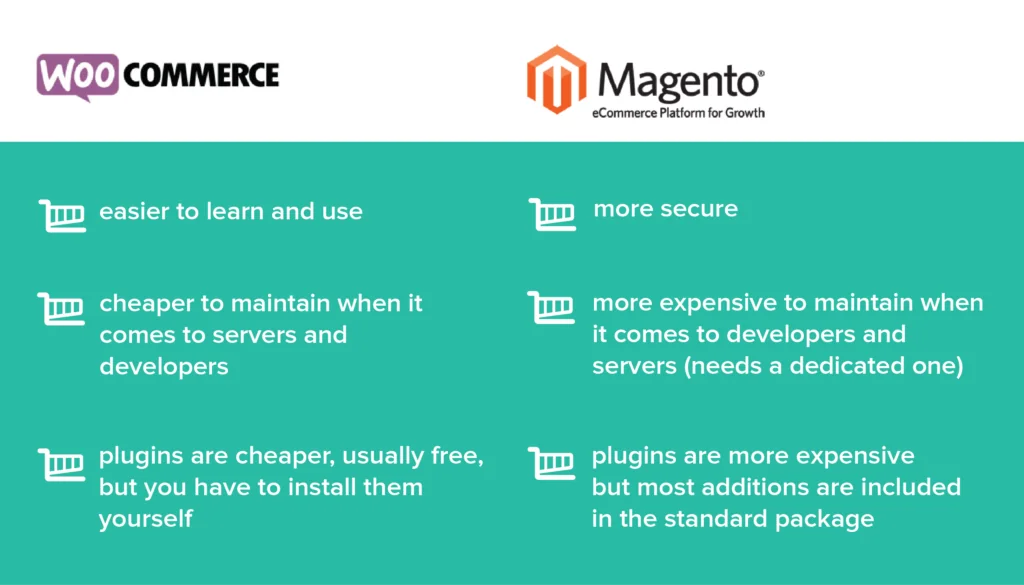WooCommerce vs. Magento – which one is better for your business?

Setting up an online store is now simpler than ever. The market is full of original products that will enable you to create and manage your an e-commerce website with ease. Two of these solutions stand out, as they take their fair share lot of the market. As of 2018, almost 30% of all online stores are handled by WooCommerce while Magento remains the most popular Content Management System available dedicated specifically to e-commerce. Let’s forget about Shopify here for a while and together take a closer look at the differences, benefits and drawbacks of these two.

Source: https://pagely.com/blog/top-ecommerce-platforms-2018-compared/
Ecommerce Usage Statistics for 2018
How are these two similar?
Both WooCommerce and Magento share a wide variety of characteristics. They are both open source and highly customizable, which means that you won’t have any trouble in picking almost any payment processors you want to use, thanks to the hundreds of extensions easily available for these two.
They both also have widespread communities and thorough documentations online that you can use to help you fight any obstacles that might be encountered while working on a store or stores. Interestingly, their strong sides differ rather significantly, and are worth considering in order to make a good choice. To each one their own, right?

Source: author’s own
The most important traits that both solutions have to offer
What makes Magento special?
Magento beats WooCommerce in the range of things it can easily accomplish without any additions or having highly specialized knowledge of the platform. It isn’t the most intuitive software in human history, but when you invest some time and eventually learn all your ropes, you will realise how powerful this tool really could really be.
It is highly customizable, dedicated to web-based stores specifically, and allows you to basically achieve whatever you can imagine in this field. There is a price that comes with this power, however – you will need a dedicated server to handle all requests associated with your website.
This step cannot be skipped or omitted, unfortunately, since the whole installation is rather heavy (much heavier when compared with the WordPress + WooCommerce mix). If you intend to make everything run smoothly on your website, a dedicated server is definitely a must-have necessity. Sorry, to break it to ya, but that’s just the way it is. Land Rover can be set as an example here, as their large store is selling not only SUVs, but also mugs, attires, baseball hats and keychains and other merchandise, is set on Magento 2 with a performance grade of 81 and a 6-second load time according to the Pingdom report available here.

Source: https://shop.landrover.com/
What draws people to WooCommerce?
WooCommerce is really appealing to people who have already their websites set up on WordPress and in a particular point in their development, they intend to add the store functionalities there. WooCommerce is practically the only solution here, since converting the whole website from WordPress to Magento would cost almost the same amount of money than preparing it in Magento from scratch. This is highly inadvisable only because of the costs involved.
WooCommerce is a technology that’s more common, less expensive to maintain and develop, and can achieve exactly the same results, without having a separate server to handle all necessary requests and with lower cost. WordPress is the most popular CMS in history, and there are several reasons for that, all of which point towards WooCommerce as a more superior solution when compared with a complicated, hard to get a hang of, separate CMS that Magento clearly is. One of the examples that uses WooCommerce is the Blue Star Coffee Roasters’ website, one of the most famous online coffee shops on the web, scoring a performance grade of 88 and 3-second load time according to the Pingdom report available here.

Source: https://bluestarcoffeeroasters.com/
What are the main differences?
The ease of use, the learning curve in both coding or managing such websites, along with the varying cost of these two, aren’t the only differences between Magento and WooCommerce. They are both immensely flexible and offer powerful marketing and search engine optimization tools, but there are also some other factors, most important of which are the community-written plugins available for both platforms.
Magento plugins are usually much more expensive to both buy and maintain, and there are much more plugins for WooCommerce available, many of which are available for free. The ability to customize your website is however in favor of Magento, as most additions you might want to include are all available there in the standard package. Some of them can be handled by the plugins, but for WooCommerce, these plugins are much more often needed.
Magento also seems to be more secure, but most of the WooCommerce security flaws that were found so far stemmed from WordPress (and have been quickly amended by the community). Both platforms are reasonably safe, but the title of the safer one (basing only on their past – both solutions are fairly secure) still goes to Magento.

Source: author’s own
A side by side comparison of both solutions’ quirks
Which option is better for me and my business?
Truthfully, both solutions are very, very good. Otherwise, they wouldn’t be as popular as they are, right? The differences between these two aren’t that severe either. The most important question is whether you’d like to have your website set on WordPress CMS or Magento CMS. In most cases, it would be better to choose WordPress and WooCommerce combination, for economic reasons and better accessibility of this platform. Currently, there are much more WordPress developers than Magento (even though they have to be specialised in WooCommerce, and not all of them are) and they are generally much cheaper. The paid parts of these two solutions (custom plugins and so on) are also generally cheaper for WordPress/WooCommerce mix. Same goes with the server maintenance and even how much power that server would demand. Practically, all what Magento has to offer can be also be achieved in WooCommerce, even though sometimes it would demand an additional plugin or two.
What about the maintenance? The updates? The regular care?
Both these solutions demand the things mentioned in the title of this paragraph, and there are some differences in terms of managing these things, too. The most important difference is also cost-related: the extra work will most probably need to be carried out by a professional and WooCommerce specialists are simply more cost-effective than Magento developers. This stems from a large learning curve and initial difficulties that new Magento devs always have to face. This solution is also often chosen by big companies with thousands of products and therefore, the market adjusts. If these big fish turn that much profit, it might make sense to charge them a lot for the Enterprise version of Magento and all work involved with this CMS. It’s that simple – they can afford it and there are people who would like to benefit from that.
And the best ecommerce solution is… the WordPress one!
There are numerous options of handling your e-commerce website, but two of these stand out. They are based on different CMSes (Magento and WordPress) but have both proven to be very resourceful, able to achieve any intent and trusted throughout the world. Both WooCommerce and Magento are your choices to go, but after weighing all pros and cons above, it becomes clear that WooCommerce has a slight advantage that is mostly based on economic factors. Easier to build and cheaper to maintain, we argue that WooCommerce is all in all a better solution. Of course, if you shoot high and your store will be big enough even after the first phase of development, it might make sense to trust with Magento first, we recommend choosing that CMS. But let’s be honest, it is highly uncommon to have that big of a store already in mind while developing your e-commerce solution :). WooCommerce is our definite winner for this one.


